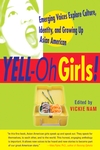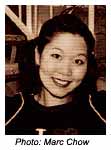|
The
Story Behind the Book Yell-Oh
Girls! :
Emerging Voices Explore Culture, Identity, and Growing Up Asian
American
 By
Vickie Nam By
Vickie Nam
"Why bother stressing out over things you can't change? That's life,
so just deal."
Alex's attitude toward most of the social crises that occurred throughout
adolescence was that if there was no way in hell he could fix something,
he'd just ignore it. Although his philosophy clashed with my own,
it was something I learned to accept over the years. After all,
he was one of the only Asian kids I'd grown up with since I was
a toddler. Alex's phlegmatic responses bewildered and vexed me,
especially as I began confiding in him about the critical observations
I was making about the predominantly white, conservative suburb
we lived in, which, in my opinion, was also a moist, dark breeding
place for prejudice. I could tell from the way his voice dropped,
and from the slow sigh that always accompanied a shaking head of
disapproval that he thought, as usual, I was being dramatic. I should
stop obsessing about imagined "differences" - racial and cultural
di fferences
that, Alex said, were apparent only to me, and not to anyone around
me. fferences
that, Alex said, were apparent only to me, and not to anyone around
me.
I couldn't understand why
Alex refused to acknowledge the injustices, which, to me, were so
plainly obvious. I wondered why we didn't see the world from similar
perspectives. But I quickly realized my error. Alex and I didn't
have to share the same worldview, just because we were both Asian.
Later, listening to other Asian American girls tell their stories
in our anthology, this idea would resonate with unforgettable force.
My mother always made time
for me. She heard me talk endlessly about how much my teachers hated
me, and that I wanted to move to Florida or California or anywhere
but where we lived. When I was finished, she offered advice that was
meant to assuage but only left me asking more questions. My mother
told me about the challenges she faced as a first-generation immigrant
- and that not being the most popular girl in the school wouldn't
be the last crises I'd ever face in my life. Her arguments were impossible
to refute. There was so little I knew about my parents' past, and
so much about their lives that peaked my curiosity. When I attempted
to talk to them about their family history, or memories of immigration,
I felt like I was paddling in quicksand. Most of the time, I thought
that they were far removed from what I was going through at school.
I wished there were a person who could challenge my views without
discounting them. I wanted someone to listen to me, to give me insight,
and to validate my emotions. I didn't want to consult peers or teachers
with my problems for fear that they, like my friend Alex, would dismiss
me as some angry little Asian girl.
The desire to reconcile
feelings of alienation and self-hatred grew, and I became interested
in embarking on a journey toward gaining a fuller understanding of
my identity. In college, I decided to take a closer look at my high
school photo album. In every photo that was ever taken of me in high
school, I'm smiling. I revisited the questions I asked myself as a
teenager - the most important one being, what feelings and experiences
were masked by that picture-perfect, model-minority smile? The album
chronicles a dreadful decade of fashion and beauty trends manifesting
an underdeveloped, Asian, female body. In seventh grade, I wore Cover
Girl pearlescent, electric blue and purple eyeliner in a style
that, according to instructions I found in a beauty bonus insert in
my teen magazine, would "widen and accentuate almond-shaped eyes."
In eighth grade, a botched iron-rod spiral perm obliterated my fantasy
of becoming L'Oreal spokesmodel Andie McDowell. In ninth, a
short wedge hairdo meant to emulate Mary Stuart Masterson's in Some
Kind of Wonderful, earned me the nickname "UFO Girl". In tenth,
my mother cringed when she saw me wearing hazel colored contacts.
They made me look moo-soh-wo - in Korean, "scary" - like a lion or
a lizard. In eleventh, Sun-In lightening solution turned my hair orange,
and I never left the house without wearing a too-puffy, size 32A,
push-up bra.
My best friend, Amy, who
is Irish-American, was also insecure about her appearance, but I think
our high-school photos tell disparate stories about how we coped with
our physical flaws. Pictures of Amy tell of a girl who felt like a
nerd wearing clunky, plastic-framed glasses. Amy cursed her dull,
frizzy, brown hair, and her pale, fleshy body. I was equally unsatisfied
with my image, but not just because I thought I looked brainiac or
fat. I was trapped in my "outsider" skin, marked for life. No amount
of lightening, tightening, or whitening would transform me into the
beautiful, glossy girls in Seventeen, or even the popular "It"
girls at school, whose blond or brunette ponytails swished from side
to side in the hallways.
The stories, poems, and
essays appearing in Yell-Oh Girls! starts a lively dialogue
about issues of identity, culture, and growing up through the perspectives
of Asian American girls - issues rarely addressed in the mainstream
magazines targeting American teen girls. In five months I generated
over 500 submissions from Asian American girls from across the U.S.
and Canada. And with the help of a friend, I launched a Web site as
an interactive accessory to the book. I prompted potential contributors
with a list of introspective questions designed to trigger a writing
frenzy and, to my delight, I received letters and submissions from
people who were eager to get involved and wanted to know more about
the anthology project. Girls from diverse socioeconomic backgrounds
and geographic locations joined our discussions about a range of topics
- interracial dating, dual identities, family conflicts and relationships,
sexuality, friendship, political activism. Later, I sought pre- published
and original essays from women whom we considered mentors, and decided
that a "mentor essay" would be placed at the end of each chapter.
This special feature would accomplish two important tasks. It would
emphasize the importance of connection between girls and women, and
make visible some successful, charismatic, Asian women whose contributions
to literature, activism, and politics would inspire girls to follow
their personal and professional dreams. The book includes insightful
essays by revered writers and organizers such as Phoebe Eng, Nora
Okja Keller, Elaine Kim, Patsy and Wendy Mink, Janice Mirikitani,
Lois-Ann Yamanaka, and Helen Zia - all critical links between young
and mature perspectives.
Once again, my mailbox is
brimming with e-mails. The inquiries are from girls who eagerly await
the release of the anthology ("When's it coming out again?"). They
are girls who are excited that somebody they know will be among the
featured contributors. Also in the mix are girls who are trying to
bridge the generation and communication gaps in their relationship
with their parents. Girls who are getting up the courage to tell their
friends that calling them "China Doll" or "Oriental" isn't okay. Girls
who want to find creative ways of resisting the pervasive stereotype
that suggests Asian women are silent, docile, sexually subservient,
exotic. Girls who are overwhelmed by the conflicting roles they are
expected to perform at home and at school. Girls who are learning
to accept and even love themselves - their bodies, their parents,
their cultural uniqueness - in the context of Eurocentric, mainstream
ideals reinforced in American culture. And, most obvious are the girls,
who, in the process of respecting the demands of people in their lives,
are searching for their own distinct voice.
In Yell-Oh Girls!
nearly seventy girls unite to challenge the idea that youth are passive
receptacles to the mass media, and parental and peer pressure. Wielding
the power of the pen, these contributors are the warrior women of
tomorrow, combating stereotypes, recovering untold stories, and taking
the initiative to change the world. At the heart of the book is the
belief that, as Asian American girls, our voices matter. --Vickie
Nam
Meet
Vicki at a Book Signing in Your Area
Above
Text © 2001, HarperCollins Publishers.
|
Buy
Yell-Oh Girls!
Read
the Exclusive AllHip Interview of
Editor Vickie Nam where she talks about her experiences
as a journalist, about editing the book, experiences growing up
Asian in America, her thoughts on Pop Culture, Mentors and on finding
her voice and personal mission.
Story About the Book
Yell-Oh Girls! Editor Vicki Nam Discusses the genesis
of the book.
Read Excepts from
the Book Yell-Oh Girls!
Alaina Wang Excerpt: "China Doll"
|





 fferences
that, Alex said, were apparent only to me, and not to anyone around
me.
fferences
that, Alex said, were apparent only to me, and not to anyone around
me.